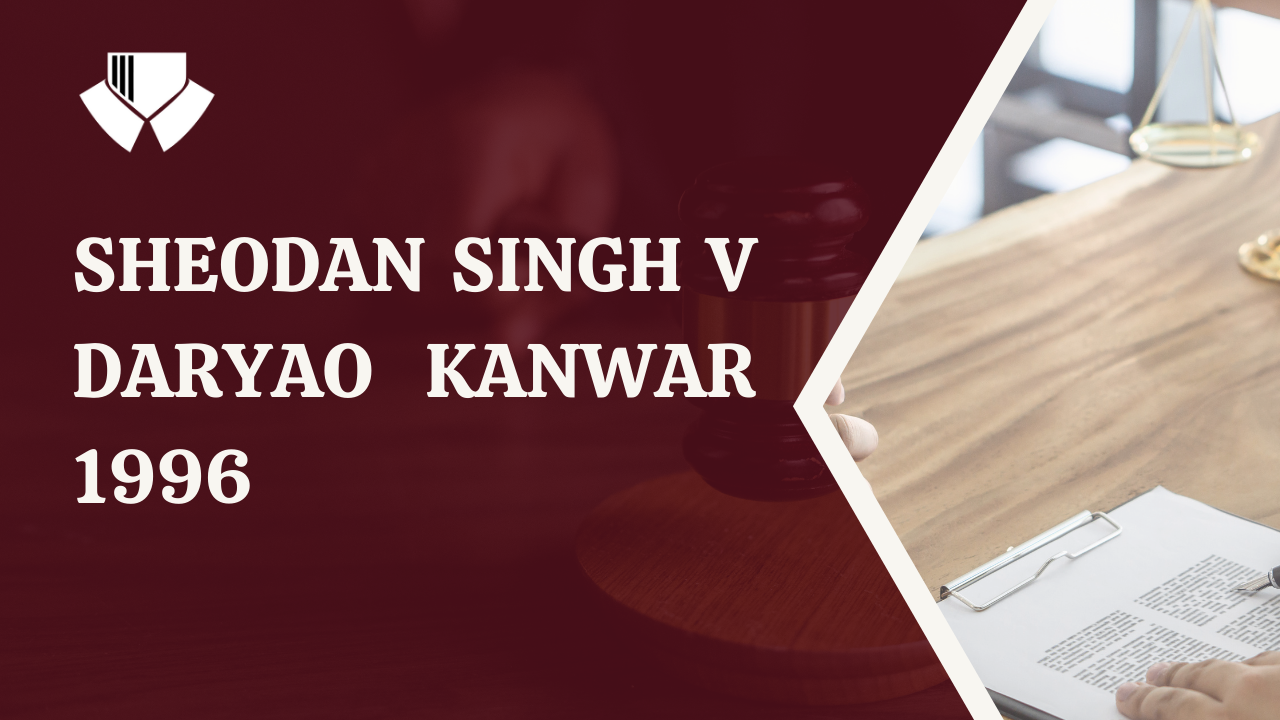Analysis by: ASHAFAK HUSEN
(Bachelor of Law, from: D.D.U. Gorakhpur, University, Gorakhpur, Uttar Pradesh 2023)
Citations: 1966 AIR 1332, 1966 SCR (3) 300
Bench: Justice Wanchoo and Justice K.N.
Date of Judgment: 14/01/1966
Petitioner: Sheodhan Singh Vs Respondent: Smt. Daryao Kunwar
Background / Facts
The case of Sheodan Singh v. Daryao Kanwar, decided on 14th January 1966, revolved around property ownership disputes. The appellant initiated two separate suits in the Civil Court, one aiming to establish his ownership of a property and the other seeking various reliefs. Simultaneously, the respondent filed two suits against the appellant in the Munsif’s court, claiming joint ownership of the property and other reliefs. These four suits were consolidated and heard together by a Civil Judge. Several issues were common among them, and the Civil Judge ruled in favor of the respondent regarding property title. The appellant appealed these decisions, but the High Court dismissed some appeals due to procedural lapses. Since the respondent’s property title had been determined, the High Court considered the remaining appeals barred by “res judicata” and dismissed them. Subsequently, the appellant appealed to the Supreme Court, raising various contentions.
Issues Involved
The key issues in this case were:
- Whether dismissals of appeals based on grounds like limitation and failure to print records should be considered as “heard and finally decided” for the purpose of applying the principle of res judicata?
- Whether decisions rendered by lower courts on common issues of joint ownership and family status could be considered as “heard and finally decided” even when certain appeals were dismissed on procedural or technical grounds?
- Whether the principle of res judicata should apply when one appeal is dismissed on preliminary grounds while decisions on common issues in other appeals stand confirmed by the appellate court?
- Whether the consolidation of suits and appeals for simultaneous adjudication affects the applicability of the principle of res judicata in cases where different suits with common issues are decided together?
- Whether the principle of res judicata can be invoked in situations where the trial court’s decision on the merits is confirmed by the appellate court’s dismissal of an appeal on procedural or technical grounds?
- Whether the decisions of the lower courts and the appellate court collectively satisfy the conditions necessary for the application of res judicata under Section 11 of the Code of Civil Procedure, considering the complex legal proceedings and the series of suits and appeals involved?
Contentions of petitioner and respondent
The appellant (petitioner) argued that:
- Dismissals of appeals based on grounds like limitation and failure to print records should not be considered as “heard and finally decided” for res judicata because these dismissals did not address the merits of the case.
- Decisions rendered by lower courts on common issues were not “heard and finally decided” by the appellate court when appeals were dismissed on procedural or technical grounds without addressing the substantive issues.
- Res judicata should not apply when an appeal is dismissed on preliminary grounds, as it does not conclusively determine the substantive issues.
- The consolidation of suits and appeals for simultaneous adjudication does not necessarily affect individual case determination, especially when different suits with common issues are being decided together.
- Res judicata should not be invoked when the trial court’s decision on the merits is not confirmed by the appellate court’s dismissal on procedural or technical grounds.
- The cumulative effect of the lower courts’ decisions and the appellate court’s dismissals does not meet the conditions necessary for the application of res judicata under Section 11 of the Code of Civil Procedure, considering the complexity of legal proceedings and the unique circumstances of the case.
The respondent argued that
- Dismissals of appeals based on grounds like limitation and failure to print records should be considered as “heard and finally decided” under res judicata because these dismissals confirmed the trial court’s decisions on the merits.
- Decisions rendered by lower courts on common issues were effectively confirmed by the appellate court’s dismissals, upholding the trial court’s findings on the merits.
- Res judicata should apply when an appeal is dismissed on preliminary grounds, as long as the dismissal confirms the trial court’s decision on the substantive issues.
- The consolidation of suits and appeals for simultaneous adjudication indicates that the issues were common among the cases, and the appellate court’s actions should be seen as confirming the trial court’s decisions on those common issues.
- Res judicata should be invoked when the trial court’s decision on the merits is effectively confirmed by the appellate court’s dismissal of an appeal on procedural or technical grounds.
- The cumulative effect of the lower courts’ decisions and the appellate court’s dismissals fulfills the conditions necessary for the application of res judicata under Section 11 of the Code of Civil Procedure, ensuring consistent outcomes and avoiding conflicting decisions on common issues.
Judgment
In the case of “Sheodan Singh vs. Daryao Kanwar,” the Supreme Court held that res judicata applied in situations where a trial court had decided multiple suits with common issues on their merits, and subsequent appeals were dismissed, even if on procedural grounds. If the result of the appeal court’s decision was to confirm the trial court’s decision on the merits, then the appeal court’s decision would be considered res judicata, regardless of the specific reason for dismissal. This interpretation aimed to prevent parties from using procedural tactics to nullify the effect of a decision made by the trial court on the merits.
The court’s ruling underscored the importance of the substance of the matter over technical considerations, aiming to prevent inconsistent judgments, promote legal certainty, and discourage parties from dismissing appeals on preliminary grounds to undermine well-considered trial court decisions. The decision aligned with the principle that res judicata prevents re-litigation of the same issues, upholding the integrity of the judicial system and contributing to a just and efficient legal system.
Conclusion
The Sheodan Singh vs. Daryao Kanwar case established a significant legal precedent regarding the application of the doctrine of res judicata. The Supreme Court’s ruling clarified that when a trial court decides multiple suits involving common issues on their merits, and subsequent appeals are dismissed on procedural grounds, the decision of the appeal court must be considered res judicata. This principle aims to prevent parties from using procedural tactics to evade the effect of trial court decisions on the merits. The judgment emphasized the importance of conclusive judicial decisions, contributing to a just and efficient legal system.


